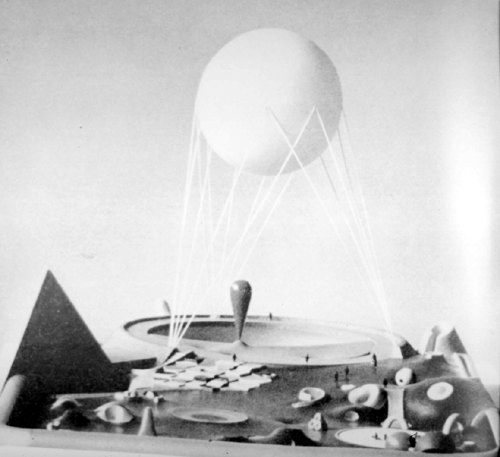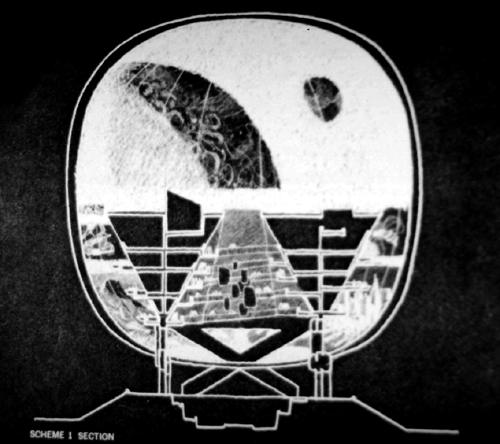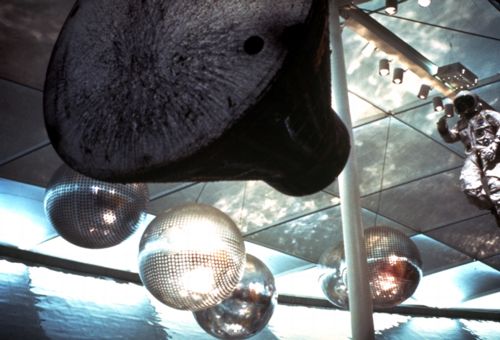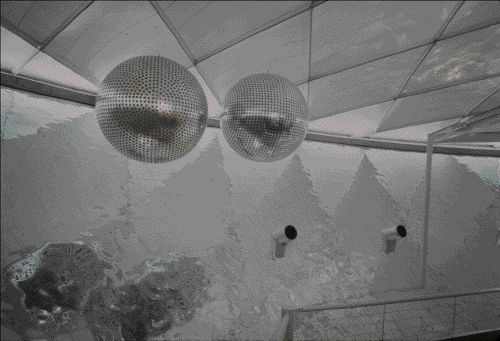
Here's a description of the American Pavilion at the Osaka '70 Expo from an online exhibit at Columbia called, "Housing The Spectacle: The Emergence of America's Domed Stadiums":
Trying to best R. Buckminister Fuller's Geodesic Dome built for the U.S. Pavilion at Expo 67 in Montreal, the architects of the Expo 70 Pavilion first envisioned it as a huge floating sphere, inspired by NASA's Apollo 11 mission that put the first man on the moon. This spherical scheme was the winning entry (submitted by Davis - Brody Architects and deHarak, Chermayeff & Geismar, Designers) in a competition sponsored by its future owner, the United States Information Agency (USIA). The competition scheme would have included exhibition space inside the sphere, and used its inner surface as a giant projection screen for continuously played film clips. The Pavilion ultimately erected at Osaka marked the birth of a new structural building type -- the longspan, cable stiffened pneumatic dome -- which would for a time become the predominant roof system over America's emerging sports palaces. Remarkably, the U.S. Pavilion's pneumatically supported 465 foot by 265 foot clear span dome was developed largely in response to Congress' 50% reduction in the project's budget. The completed Pavilion cost $450,000, which was about half the cost of the Montreal dome.Those budget cuts meant The Great Balloon was replaced by a flat, quilted dome derided as "the world's largest bunion pad."
"Space balloons" were a prominent element in another of designs invited by the US Information Agency. According to an exasperated-sounding 1968 Architectural Forum review of ten of the eleven invitees, Isamu Noguchi proposed an underground exhibition space topped by a "vividly colored" and contoured playground landscape, comfortably shaded by a giant balloon. A space balloon.

Davis Brody's winning plan for the Great Balloon originally included a spiral exhibition-filled ramp leading up to a panoramic platform where films would be projected on the entire upper half of the dome.

When that didn't work out, the quest for giant, space exploration-evoking spheres, though, seems to have been moved inside. I can't make much sense of the exhibition design or its purpose from photographs [the clearest picture I've seen so far is a tourist's snapshot], but there were certainly some Project Echo-esque Mylar spheres floating in there.

Also, the entire surface of the earth berm walls were covered in silver Mylar.

Especially with the dot-covered spheres, you see how short a trip it is from the Triumph of the Cold War and the Space Race to the Age of Disco.
There are more and larger images at the Columbia site. [columbia.edu]
The US at Osaka, Arch Forum, Oct. 1968 [hosted at columbia.edu]
Previously considered unrelated. Now? Helmut Lang's self-portrait, a scavenged, battered disco ball












